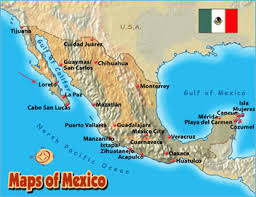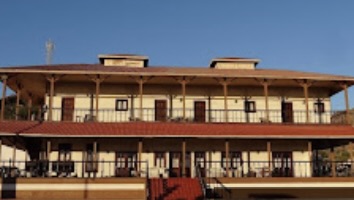A continuation of a trip which started on Feb 15th
Loreto - 2/15-17 (here)
Leaving Loreto area behind


The drive up North, from Loreto to San Ignazio, Baja CA peninsula via the Pan -Americana- Hwy 1, takes at least 4 hours
on relatively narrow 2 lanes.
It passes through mostly mountainous desolated desert, small enchanting beaches
by the Cortez Sea, few small villages and 2 historic towns of Mulege and Santa Rosalia

The warm clear blue sunny sky weather
promised, a wonderful excursion day. though a very looong drive..
The lingering barren desert against the backdrop of the impressive mountainous landscape, was initially very monotonous and doted mainly by low dry bush and erect majestic Mexican cactus.
There were hardly any other cars seen on the road at this segment of the way..

At times, the flock of the Mexican vultures (ZZopilote Negro..) known also as American black vulture, hovering, above in air, would select especially a
tall cactus poll, on which its top, one vulture at a time, would land, and take a sit, either to rest or to scout, in search of the next scavenger hunt.
The sitting of this black predator on top of the green prickly cactus is a true decorative, natural art site, within this monotonous landscape.


An hour and a half into the drive through the arid landscape, an elongated bluish narrow water bay suddenly, revealed itself, and magnetized my gaze through the car's window. The spectacular coastline views of the desert meeting the sea make up the Bahia Concepcion. It is one of the largest bays of the Baja California Peninsula, along Hwy 1, of about 20 miles (32 km) south of the town of Mulegé

Bahia Concepcion

Then the oceanic water body expends , and small white sandy bays appear at the foothill shore, where, colorful canoe boats gliding on the calm bluish water, can be spotted, and rows of RV travel mobile homes parked neatly, next to mangrove ponds, can be seen.

Along the Bahia Concepcion there are at least 7 poplar Beach places for those who love slow life, and nature modest rugged vacation

Here are the names of the Playas and rules of conduct posted
Play Armenta,
Playa Santispac,
Playa El Requeson,
Playa Buenaventora
Playa el Coyoty
Plays les Cocus,
Playa el Burro,
Playa Los Marinjos

Apparently, in addition to the incidental travelers, many Americans living off their modest Social Security pension, choose this vagabond, yet much more, affordable life style, frequent these Baja beaches and shores

There are several bays, islets, protrusions and beaches along the way, that makes the drive along this part of the way, much more interesting and pleasant to the eye
Posada Concepción is also a small private community by the bay south of Playa Santispac
Also traffic picked up traction at this segment of the way, and many semi trailers trucks, hogging the road, need to be watched, especially on the elevated curvy segments.

It seems that the Mexican army also makes sure that the beaches are safe, conduct rules are maintained, and that there are no drugs trafficking crimes ..
It was quite scary seeing 6 army pick-up trucks loaded with armed shielded men, racing down toward the beach at the peaceful Playa Santispac,


At the third hour of the drive, a charming oasis, away from the sea, covered by verdant Palms along the water stream, by which we shortly stopped, took us totally by surprise.
The Palm Oasis of Molgeh


The entire peninsula of Baja California is an area with one of the lowest precipitation rates in the world, thus stepping into a lush green rich in Palms oasis, in the midst of this arid area was mind blowing, It resembles the ones
we also encountered in the trip to Morocco, but I wasn't expecting to find in Baja..

Mulegé is a small town, of about 4000 inhabitants, in the north of the state of Baja California Sur, where we only briefly stopped, on our way up north.
It is one of the few places in the arid Baja desert where there is a freshwater source.
The Rio Mulege streams through the town and provides life to the lush palm groves, mangroves and swathes of green in an otherwise dry land.

A beautifully preserved Jesuit mission started here, when In 1702, Jesuit Father Juan Maria de Salvatierra identified the valley of today's Mulegé, as a place for a mission to the Indians. It was not until 1754 that Father Francisco Escalante started the construction of the mission, called Misión Santa Rosalía de Mulegé
The second and larger town where we had a longer stop, and lunch and which totally took us by second surprised was :


Situated along the Gulf of California. on the east coast of the Baja Peninsula, Santa Rosalia is a Port city, which was founded in 1884 as a French mining company town by the Compagnie du Boleo ,the first operated, on a large commercial scale. The company obtained control of the property and began mining, after receiving an extensive concession and 70-year tax exemption granted by Mexican president Porfirio Diaz.

In 1885 the Mexican Gov and Mr. Aizenmann, together with Mr. Manuel Tinooco signed an agreement that founded the Santa Agueda Mineral Colonony, guaranteeing the House of Rothschild and Mirabu Bank the acquisition of 20,627 hectares of land, that would be exploited by the
"El Boleo" company

It was established as the local copper mines and exploited the mines there until it closed in 1954.
The abandoned mine is cut directly into the town's hillside. and is very visible when driving through town
The commercially mine copper, Boleo Mine is an unusual sediment-hosted copper-cobalt-zinc-manganese ore deposit. in which hundreds of workers, Chinese, Japanese, Yaqui Indians and Mestizos were brought in to work in the mine. and died working, as the company exploited the workers and employed labor-intensive practices with poor safety conditions.

At the end of the 19th century, El Boleo was known as the Mexican capital of copper, producing 11,000 tonnes of pure copper annually, about half of Mexico's total copper production
The French company operated until 1954, when the tax exemption expired. The project then went bankrupt and the mine was shut down.


The industrial facilities which are located in the very middle of the town, were never dismantled, and the foundry, old locomotives, mining equipment and machinery are visible everywhere,, decorating the town's historic past .
.


The town had a population of about 14,500 inhabitants and till today it boasts French influence, particularly in its architecture. which is very well preserved, and also still gives the feel of a "pioneering" era
Historical colonial houses built by the company can be found at the town's lower center like the metallic Iglesia de Santa Bárbara. and on the top of the hill

Perhaps most well-known in town, is this metal prefab church, designed, not other then the known Gustave Eiffel - the architect of the Eiffel Tower, which took first place for both this church and the tower, at the 1880 World Fair in Paris.
The church was shown in Paris at the 1889 Exposition Universelle and acquired by the Boleo Mining Co. - Carlos La Frogue, He acquired the church and had its metal plates brought to Santa Rosalia, where it can be visited right in town center.
More that can be seen in the lower Town's Center


Panaderia El Boleo - French bakery
Álvaro Obregón, Centro, 23920 Santa Rosalía,
This French bakery was established in 1901. The making of French and Mexican pastries in their rustic facility., can be watched.
Mulle Restaurant Private Kindergarten The way to the hill top
The architectural French influences are still very present, where the rich people lived in the French Quarter at the highest elevations of town, mainly on the Jean Michel Gustau main St. It overlooks the town,and the impressive vistas of the harbor ..
Use of wood to construct the homes and businesses. inspired by the owners of the Boleo mining company. are visible, .as are old world touch of wooden porches and gingerbread décor .
At the French Quarter on Top of the Hill

This National Historic Monument was founded in 1886, also by the Boleo mining company
This is a good option to stay the night in Santa Rosalia, or one can just come to have a look around the historic hotel property, that evokes a period from a century ago.

The main mining company building
(La dirección) has been reconverted into the city hall and its offices into an industrial museum
It features a mining history museum full of old mining equipment that gives visitors a glimpse at what it might have been like to work in the mines
The Roteray International Club Building

Cruise ships anchor here, infrequently.
A ferry runs between Santa Rosalia and Guaymas (main land) a few times a week.
Late that afternoon, we finally reached another small quint Oasis Town -San Ignacio
where we were due to spend the night, prior to arriving at the wale Watching camp at the San Ignacio Lagoon
To be Continued....
Ignacio Springs Bed & Breakfast, San Ignacio BCS




































































































Comments